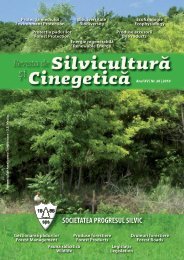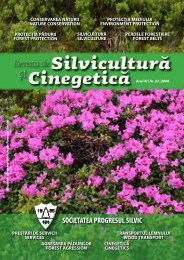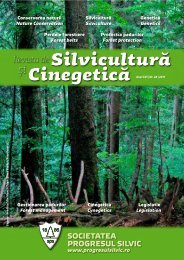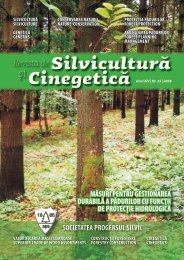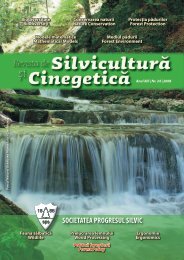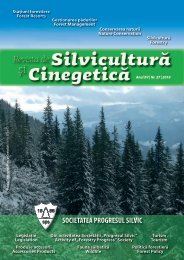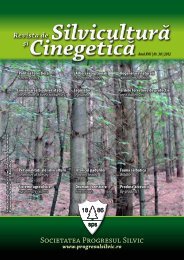Silviculture and Cinegetics Review - Societatea Progresul Silvic
Silviculture and Cinegetics Review - Societatea Progresul Silvic
Silviculture and Cinegetics Review - Societatea Progresul Silvic
Create successful ePaper yourself
Turn your PDF publications into a flip-book with our unique Google optimized e-Paper software.
FORESTRY POLICY SILVICULTURE AND CINEGETICS REVIEW XVII/30/2012<br />
Vînători 67.38 - 67.38<br />
Dîrvari 13.62 8.46 22.08<br />
Cujmir 51.37 38.34 89.71<br />
Total 880.12 361.85 1241.97<br />
4. Conclusion<br />
Specific conditions in the plains Mehedinţi County<br />
have required the preparation of projects for the<br />
location of forest belts for farml<strong>and</strong> protection <strong>and</strong><br />
improvement of environmental conditions.<br />
After a preliminary study of the natural environment<br />
(climatic conditions, soil map, forest planning) it was<br />
passed to the design phase, the first step being picking<br />
field data (analysis of soil, vegetation study, location<br />
of forest belts networks depending on wind direction,<br />
etc.).<br />
Depending on soil types <strong>and</strong> subtypes, on limiting <strong>and</strong><br />
compensatory stationary factors, there have been<br />
Bibliography:<br />
Haralamb A., 1956. Cultura speciilor forestiere. Ed. Agrosilvică,<br />
Bucureşti.<br />
Stănescu V., Şofletea N., Popescu D., 1997. Flora<br />
forestieră lemnoasă a României. Ed. Ceres, Bucureşti.<br />
Tîrziu D., 1997. Pedologie şi staţiuni forestiere. Ed. Ceres,<br />
Bucureşti.<br />
established six stationary units. For each stationary<br />
unit there were established main <strong>and</strong> alternative<br />
afforestation compositions, based on each unit’s<br />
favorability for certain species.<br />
The designed forest belts networks total an actual area<br />
of 1242 ha in the county, of which 880 ha are main<br />
forest belts <strong>and</strong> 362 ha secondary forest belts.<br />
We believe that by installing these forest belts the<br />
agricultural production will increase; the local climate<br />
will improve <strong>and</strong> will benefit from other advantages<br />
that protection forest belts bring (additional<br />
contribution of wood to the population, reducing the<br />
cost of irrigation, improve habitat for game <strong>and</strong> birds<br />
useful to agriculture, etc.).<br />
***, 1968: Clima R.S.R II. Date climatologice. Comitetul<br />
de Stat al Apelor, Institutul Meteorologic, Bucureşti.<br />
***, 2000: 1. Norme tehnice privind compoziţii, scheme şi<br />
tehnologii de regenerare a pădurilor şi de împădurire a<br />
terenurilor degradate. MMAP, 2000.<br />
Abstract<br />
The low share of forests in Mehedinti County (6% of the territory), the increasing occurrence of prolonged droughts in the<br />
last decades impose the placement of networks of field protection forest belts to protect farml<strong>and</strong> <strong>and</strong> improve<br />
environmental conditions.<br />
In the drafting of the projects for placement of protection forest belts were studied, in a first stage, the natural environment<br />
elements. During the field works the study of vegetation was done, soil samples were collected for analysis, <strong>and</strong><br />
measurements were made for mapping the networks of main <strong>and</strong> secondary protection forest belts by township (depending<br />
on the prevailing wind direction).<br />
During the office stage, after establishing the soil types <strong>and</strong> sub-types (indicating their favorability for some species) <strong>and</strong><br />
the analysis of the limiting <strong>and</strong> compensatory stationary factors, 6 stationary units were established. These were outlined on<br />
the maps.<br />
For each stationary unit, based on their phytocenosis aptitude, main <strong>and</strong> alternative afforestation compositions were<br />
established for the main <strong>and</strong> the secondary forest belts. The forest belts networks were designed in the area of 16<br />
townships, 1242 ha in total, of which 880 ha main forest belts <strong>and</strong> 362 ha secondary forest belts.<br />
Keywords: forest belts, Mehedinţi Country, stationary factors<br />
Translated by: Roxana Gabriela Munteanu<br />
26



